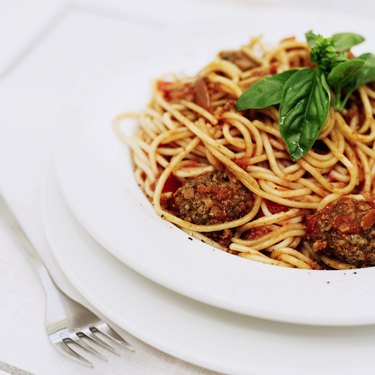
Although grain-based foods can be part of a nutritious diet, not all grain products have the same impact on hunger and satiety. Some pastas, especially varieties made from refined grains, can leave you feeling hungry soon after you eat them. Whereas items made from white flour or other heavily processed starches can keep your appetite roaring, foods made from fiber-rich whole grains can help you feel full longer.
Description
Video of the Day
Pasta -- as well as most other grain products -- generally fall into one of two categories: refined grain and whole grain. Refined grains have the bran and germ removed, leaving them lower in fiber and other nutrients. Whole grains, by contrast, contain all parts of the grain and have higher concentrations of fiber, vitamins and minerals. Unless labeled otherwise, pasta is usually made from refined wheat flour or another refined grain.
Video of the Day
Effects
Pasta and other foods made from refined grains have a distinct impact on satiety and hunger levels. According to a study published by Hanna Isaksson, et al., in "Food and Nutrition Research," a breakfast made from refined grains failed to lower hunger or provide satiation as effectively as a whole-grain breakfast. The whole-grain breakfast also resulted in a reduced desire to eat for up to eight hours after consumption, whereas the refined grains didn't curb the subjects' appetites. The researchers speculated that the higher fiber content of the whole grains slowed down digestion and triggered satiety hormones, but the refined grains did not. As a result, pasta and other refined-grain foods may fail to satisfy your appetite, resulting in hunger soon after eating.
Solution
To reap the benefits of grain products like pasta without feeling ravenous after eating them, look for whole-grain versions of your favorite foods. The Mayo Clinic recommends checking food labels for the word "whole grain," looking for whole grains near the top of the ingredients list, and selecting products that provide 3 grams or more of dietary fiber in each serving. Common sources of whole grains include barley, millet, oatmeal, bulgur, buckwheat, brown rice, whole-wheat bread, popcorn and wild rice.
Considerations
Although refined versus whole grains have distinctly different impacts on hunger, not all whole grains are equally filling. According to a study published by Natalia Schroeder, et al. in "The Journal of the Federation of American Societies for Experimental Biology," subjects eating wheat felt significantly hungrier than those eating a similar portion of barley, even though both foods were whole grain. If you experience unusual hunger after eating wheat-based pasta, even whole grain varieties, consider choosing a product made from a different grain source.
- "Food and Nutrition Research"; Whole Grain Rye Porridge Breakfast Improves Satiety Compared to Refined Wheat Bread Breakfast; Hanna Isaksson, et al.; July 2008
- "The Journal of the Federation of American Societies for Experimental Biology"; Comparison of Energy Intake and Satiety for Whole Grain Barley, Wheat and Refined Rice; Natalia Schroeder, et al.; 2008
- Mendosa.com: Living With Diabetes; What Really Satisfies; David Mendosa; January 2005